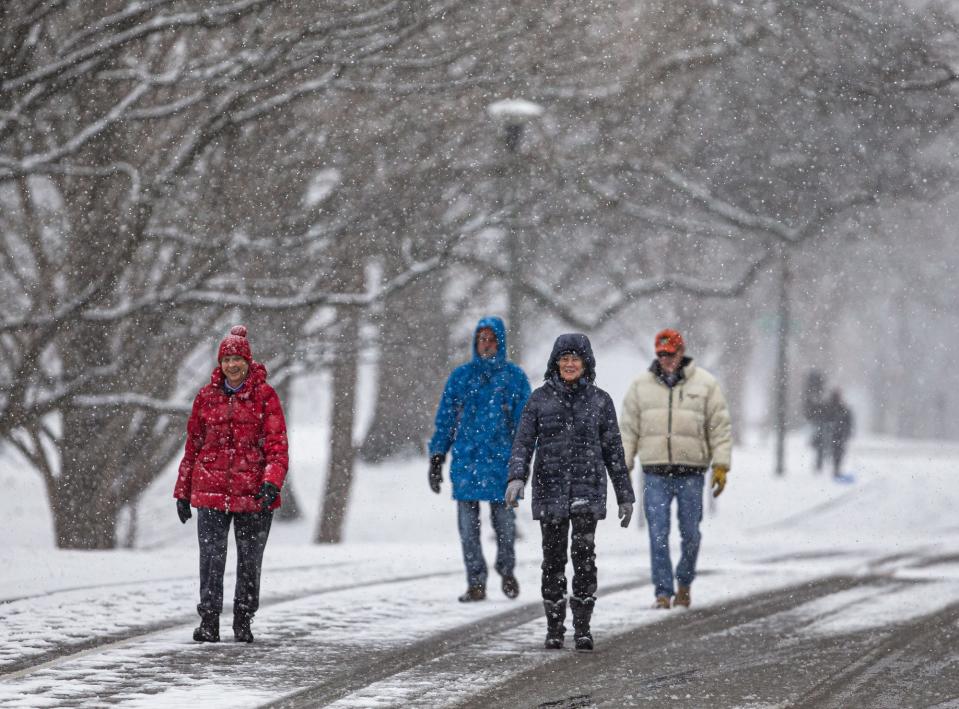State of Mind: How can we combat burnout and seasonal affective disorder?
I can't remember the last time I took a real vacation. You?
My ideal vacation? No phones, no bending my neck down into a 3-inch screen of endless information to read about the latest filtered takes. I would wander the outdoors without a schedule or itinerary, guided by curiosity and wonder. I like to imagine putting my palm against a tree, breathing in that delicious scent of petrichor and listening to critters scurrying along the forest floor. Really tune in to the natural world that seems less attainable by the day, less defined by "the real world."
Maybe your ideal vacation involves lying on a beach and ordering a drink with a little umbrella in it. But whether you like to bust out your bathing suits or tie up your hiking boots, unplugging from work is at the heart of the desire to get away.
Recently, my colleague AnnMarie Hilton reported on a course offered by Lawrence University called "Doing Nothing." It's tempting to ridicule the notion of throwing historically high tuition costs toward a lesson in doing nothing, especially amid fiery debates around college loan forgiveness, but as Jenny Odell writes in her New York Times Bestseller book "How to Do Nothing: Resisting the Attention Economy," it's hard to do nothing these days.
Most of us are strapped into the grind, and it only worsened during COVID-19, which cost many of us additional work-life boundaries on top of the need to stretch every dollar to make it to the next paycheck. We heard the term "quiet quitting," a COVID-fueled phenomenon in which employees no longer volunteer additional time to their employers. Who has time to go above and beyond during a period of mass deaths and mysterious illnesses from a constantly evolving virus, searing political division, record inflation costs and a shrinking direct care workforce from child care providers to adult daycare centers?
It's hard to find relief when our home has transformed into a one-stop shop of toil as an office, day care center, gym and living quarters ― all of which require upkeep. Without different environments separating our career-oriented selves from our homebody selves, it's no wonder we're losing grip on healthy balances.
Being overworked is also converging with seasonal affective disorder, which brings me to the main question I received from a reader. They asked, "How can people combat the upcoming obstacles of burnout and seasonal affective disorder that’s just around the corner?"
First, let's really define the two syndromes.

Charles LaTorre, a behavioral health counselor at Bellin Health, defined seasonal affective disorder as the strong tendency to be depressed at a specific time of the year. Late fall and winter tend to be the most common periods of the year for the disorder to strike, as it typically results from less time in the sun and a vitamin D shortage. Recent days of beautiful, sunny weather have delayed some of its onset, LaTorre said, but the season for this malady is coming.
Lisa Tutskey, a licensed marriage and family therapist at Prevea Health, said it's easy to feel overtaken by seasonal affective disorder even if you enjoy all that comes with fall and winter. She described a perennially familiar winter day in Wisconsin: waking up in the dark, going to work in the dark and leaving work in the dark.
With darkness everywhere, Tutskey said, people tend to feel rudderless and without purpose when there's so little exposure to daylight.
Low energy overlaps with this reader's other concern. Burnout syndrome amounts to energy depletion and exhaustion, increased emotional distance from the things that normally matter to you, feelings of negativity and cynicism toward yourself, others and the general world, the quality of your work suffering and, importantly, being unrecognizable to yourself, to others.
Burnout sounds like the pits even without a world-rending pandemic. And COVID burnout is its own beast. In addition to the above problems, the collective stress that came with uncertainty, division, either living in isolation or on top of each other, grief, loss, a lack of social connections, and then the dismissal of harm all swirled into what LaTorre called "the great fatigue."
"This is unchartered. Never, ever have we all globally gone through the same intensity of one thing together," LaTorre said. "One area of a country may have a wildfire and another one may have floods, maybe there's something going on in Italy, and you'd be doing great in Florida. With COVID, everybody everywhere felt the collective emotional shift."
'Even a Ferrari without gas is just another parked car'
To fully comprehend the power of recovery, LaTorre likes to share a parable: Two men are in the forest chopping wood, with the goal of cutting as much wood as possible throughout the day. One of the men goes about his business with a fury, striking his axe against as many logs as he can without stopping. The other takes a more leisurely approach, taking a break in the morning, for lunch and again in the afternoon. The first man is frustrated by the other's need to constantly rest. You can imagine the type: huffing, puffing, grumbling about the other's weak constitution.
When the end of the day comes, however, it's the second man who's chopped more wood, not the one who continuously labored. Sweating and now even more irritated, the first man asks the second how he did it. The second man responds, "Every time I took a break, I sharpened my axe."
It's easy to minimize the importance of taking a break when the prospect of powering through has been ingrained in us since our early years. Most of us know somebody who has bragged about never missing a day of work in their life, as though running on empty were a worthier badge of honor than taking time to recharge and reflect on our one "wild and precious life."
"The issue with burnout is a lot of people take great pride in thinking they don't need rest, that they could run on only four hours of sleep," LaTorre said. "The most commonly plagued American worker is the one who doesn't recognize that recovery is as important as productivity. "
LaTorre explained that human beings run on two systems: the circadian rhythm, which is the natural internal process that regulates sleep in a 24-hour period, and the lesser-known ultradian rhythm, a recurrent cycle repeated roughly every 90 minutes throughout a 24-hour period.

The man who throws his ax every direction for eight hours is ignoring the ultradian rhythm, those moments interspersed throughout the work or school day where our attention spans start to fizzle out. Our cognitive function tends to start declining after about 90 minutes, which makes that coffee break not only justifiable but physiologically necessary.
"Doing something every 90 minutes, even if it's standing up and sitting down in and of itself doubles your metabolism while giving your back a break," LaTorre said. "Having strategic recovery is the best way to overcome burnout. As I always like to say, even a Ferrari without gas is just another parked car."
So, how do we deal with these converging feelings?
So many of us have been eager to push through these last traumatic years, but Tutskey from Prevea Health said there's power in sitting with those emotions and feelings. We really owe it to ourselves to feel them.
"As a society, we often don't sit with emotion, and we have not necessarily been taught how to cope with emotion. We categorize emotion as negative or positive, when, actually, emotion is just emotion," Tutskey said. "Much of the time, we feel like that emotion, though, is going to just overtake us and overwhelm us. We do lots of things to distract ourselves."
Checking in with how we are, Tutskey said, can be extremely beneficial. When's the last time you asked yourself how you felt and really analyzed it? And when is the last time you accepted your feelings of anger and sorrow? Castigating the feeling, Tutskey said, doesn't make it go away. It just enables our tendency to bury our emotions, which is the worst method of lessening our stress levels.
To that end, we're not prone to looking at these pandemic years as something we've fought to survive, but Tutskey said our brains have indeed been in fight-or-flight mode for a long time, and not solely because of the pandemic. Tutskey described these years as a time of great unrest, be it a result of political unrest, social unrest, or financial unrest.
"Once things started to return to normal, it was time for everybody to take a breath, but when we stop and take a breath is when we start to feel the effects of what we went through," Tutskey said.
This period has also led to our recalibrating our sense of "normal." We had to figure out who we missed, who we didn't miss, and we had to grieve whatever we believed to be our normal lives. That way of living, whether we're willing to acknowledge it, has changed.
The way LaTorre sees it, movement can be a powerful coping skill. He recommends what he calls the 10-10-10 strategy. If you budget in a 30-minute walk, which LaTorre strongly recommends for its multiple benefits of sunlight exposure, exercise and social connection, split that walk into three different intervals throughout the day. A 10-minute morning walk, a 10-minute post-lunch walk, a 10-minute afternoon walk. Sounds a little like the man who chose to rest and sharpen his ax, no?
To make those walks more exciting, LaTorre said you can turn them into a game or fold a hobby into them. If you like taking photos, you can make those walks photography opportunities. If you like watching nature, see how many different species of animals you can note along your walking path.

As for seasonal affective disorder, LaTorre said the most crucial window to get natural sunlight in is in the morning, about 30 minutes after you wake up. He recommends buying a light therapy lamp, which mimics natural outside light, and sitting in front of it while eating breakfast or reading the paper.
"One of the biggest problems with seasonal affective disorder is that their sleep pattern is disrupted. But when you can do this, it helps your sleep hygiene too, getting you a better night's sleep," LaTorre said. "Plus, you're getting that blast of light earlier in the morning."
In moments of anxiety or stress or exhaustion, Tutskey recommends listening to what your body needs. She's loath to say practice self-care because self-care has been co-opted by wellness culture and, believe me, no face cream is going to fix exhaustion.
In lieu of buying expensive products in the name of self-care, she recommends small things. Drinking water, making a meal that sounds good, going to sleep when you're tired. Hell, eat a cupcake if you want a cupcake.
"We have made what it means to be healthy such a small, narrow window, and that doesn't work for everybody. So let's stop villainizing all of the things and let people live their lives," Tutskey said. "Let people be brave enough to say, 'This is what I enjoy. This is what I don't enjoy.' I think that that's important."
Next time, on State of Mind
'Tis the season, as they say. Next month, we'll explore one reader's question about the connection between mental wellness and religion, belief and houses of worship.
Have an idea for an upcoming column post? Don't be shy. Ask away.
Be well, Wisconsin.
Natalie Eilbert covers mental health issues for USA TODAY NETWORK-Central Wisconsin. She welcomes story tips and feedback. You can reach her at neilbert@gannett.com or view her Twitter profile at @natalie_eilbert. If you or someone you know is dealing with suicidal thoughts, call the National Suicide Prevention Lifeline at 988 or text "Hopeline" to the National Crisis Text Line at 741-741.
This article originally appeared on Green Bay Press-Gazette: Mental health tips on seasonal affective disorder and burnout: Eilbert

